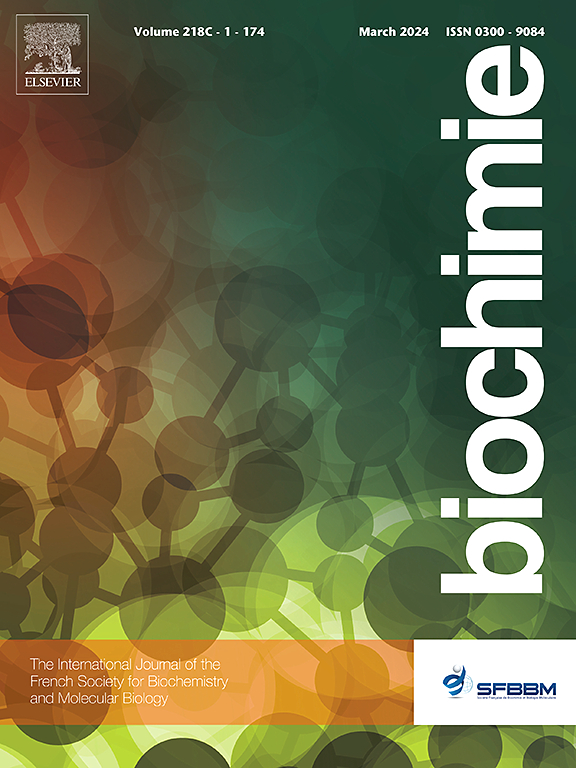Recombinant expression and purification of wheat aminoacyl-tRNA synthetases and IRES-dependent polypeptide synthesis with homogeneously derived purified factors
IF 3
3区 生物学
Q2 BIOCHEMISTRY & MOLECULAR BIOLOGY
引用次数: 0
Abstract
Reconstitution of the translation system including the full set of aminoacyl-tRNA synthetases (ARSs) has been achieved with the components from Escherichia coli and human. We are trying to reconstitute the plant translation system because plants are also essential targets of biotechnology. Some eukaryotic ARSs form multi-synthetase complexes (MSCs), while plant MSCs have not been fully characterized by the conventional top-down approaches isolating them from plant tissues. To reveal more about the plant MSCs by bottom-up approaches and to reconstitute the plant translation system, we attempted here to prepare individual wheat ARSs by E. coli expression methods and sequenced tRNAs expressed in wheat germs. The 16 ARSs other than CysRS, IleRS, LysRS and ThrRS were synthesized in E. coli and were purified to near homogeneity. Fourteen of them other than ValRS and AsnRS had their aminoacylation activity. Then, the 6 ARSs that were not prepared successfully in E. coli (ValRS, AsnRS, IleRS, ThrRS, LysRS, and CysRS) were synthesized in a wheat-germ cell-free translation system and purified. As a result, ThrRS and ValRS, but not the other four, could aminoacylate wheat germ tRNA. Some of the unsuccessful ARSs might require unidentified co-translational interactions for formation of their active forms. Finally, a reconstituted wheat translation system containing 8 ARSs, eEFs, eRFs, ribosome, and total tRNA was constructed. The system successfully translated an mRNA encoding a hemagglutinin-tag and a randomly generated sequence of 5 amino acids downstream of a cricket paralysis virus internal ribosome entry site, which enables translation independent of initiation factors.
小麦氨基酰基trna合成酶的重组表达和纯化及ires依赖性多肽合成均质衍生纯化因子。
利用大肠杆菌和人的成分重建了包含全套氨基酰基trna合成酶(ars)的翻译系统。我们正试图重建植物翻译系统,因为植物也是生物技术的重要目标。一些真核ars形成多合成酶复合物(MSCs),而植物MSCs尚未通过传统的自上而下的方法从植物组织中分离出来。为了通过自下而上的方法揭示更多关于植物间质干细胞的信息,并重建植物翻译系统,我们试图通过大肠杆菌表达方法制备单个小麦ars,并对小麦胚芽中表达的trna进行测序。在大肠杆菌中合成了除CysRS、IleRS、LysRS和ThrRS外的16种ars,纯化后均接近均匀性。除ValRS和AsnRS外,其余14种均有氨基酰化活性。然后,在无小麦生殖细胞翻译系统中合成了在大肠杆菌中未成功制备的6个arrs (ValRS、AsnRS、IleRS、ThrRS、LysRS和CysRS)并进行了纯化。结果表明,ThrRS和ValRS能使小麦胚芽tRNA氨基酰化,而其他4种不能。一些不成功的ars可能需要未知的共翻译相互作用来形成其活性形式。最后,构建了包含8个ars、eEFs、eRFs、核糖体和总tRNA的小麦翻译体系。该系统成功翻译了编码血凝素标签和蟋蟀麻痹病毒内部核糖体进入位点下游随机生成的5个氨基酸序列的mRNA,使翻译不受起始因子的影响。
本文章由计算机程序翻译,如有差异,请以英文原文为准。
求助全文
约1分钟内获得全文
求助全文
来源期刊

Biochimie
生物-生化与分子生物学
CiteScore
7.20
自引率
2.60%
发文量
219
审稿时长
40 days
期刊介绍:
Biochimie publishes original research articles, short communications, review articles, graphical reviews, mini-reviews, and hypotheses in the broad areas of biology, including biochemistry, enzymology, molecular and cell biology, metabolic regulation, genetics, immunology, microbiology, structural biology, genomics, proteomics, and molecular mechanisms of disease. Biochimie publishes exclusively in English.
Articles are subject to peer review, and must satisfy the requirements of originality, high scientific integrity and general interest to a broad range of readers. Submissions that are judged to be of sound scientific and technical quality but do not fully satisfy the requirements for publication in Biochimie may benefit from a transfer service to a more suitable journal within the same subject area.
 求助内容:
求助内容: 应助结果提醒方式:
应助结果提醒方式:


